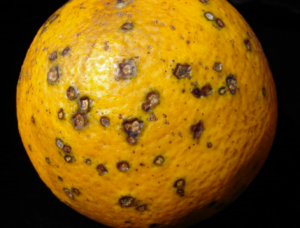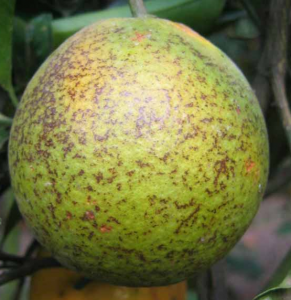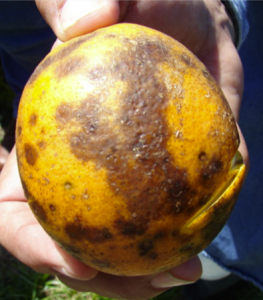Recently, USDA-APHIS added 195 sections across Florida in Charlotte, Collier, Glades, Hendry, and Lee counties to the citrus black spot (CBS) quarantine list. Citrus black spot is a disease is caused by the fungal pathogen, Guignardia cirtricarpa (Anamorph: Phyllosticta citricarpa). Thriving in subtropical climates, it’s current distribution is fairly widespread with observations reported across several continents.

Symptoms can be seen on both the fruit and leaves. While leaf symptoms are less common, they may be found on more susceptible citrus varieties or nutrient stressed plants. Lesions on infected fruit can be variable, dependent upon maturity and fruit type. For this reason, fruit lesions are typically grouped by descriptive names including hard spot, cracked spot, false melanose, freckle spot, and virulent spot.

Hard spot is the most commonly observed symptom of citrus black spot. These lesions are comprised of asexual fruiting bodies, or pycnidia, and are generally between 3-10 mm in diameter, with tan to gray centers and a distinct brick-red to dark brown margin. The asexual spores, or conidia, produced within these fruiting bodies, or on infected leaves, are then spread through wind or water dispersal. Cracked spot lesions are typically darker, smooth, and have variable size and margins. Initially present on immature, green fruit, these lesions are often associated with rust mite damage. False melanose tends to occur on immature, green fruit and lesions are generally 1-3 mm in diameter, round, sunken, and reddish in color. These lesions may be singular or coalesce to form virulent spot toward the end of the growing season. The progression of this disease to virulent spot lesions results in discoloration of large areas of the rind and premature fruit drop.

As this pathogen is still limited to southern areas of Florida, strict regulations are in place to aid in limiting its spread and further detriment to Florida’s already fragile citrus industry. If you think you may have discovered citrus black spot, be sure to contact your local county extension agent who can further assist with notifying a state citrus contact.
Be sure to check out the following links for more information: Citrus black spot in Florida – FDACS, Interactive Citrus Federal Quarantine Map, FDACS-DPI Pest Alert: Citrus black spot, USDA-APHIS Citrus black spot.
Source: UF/IFAS Pest Alert



